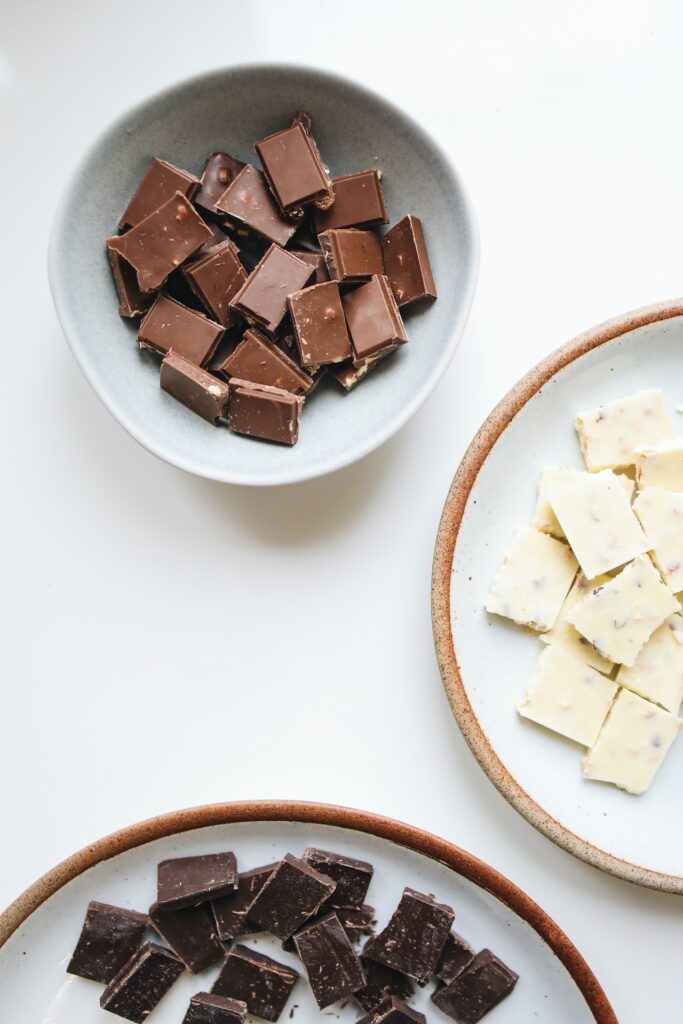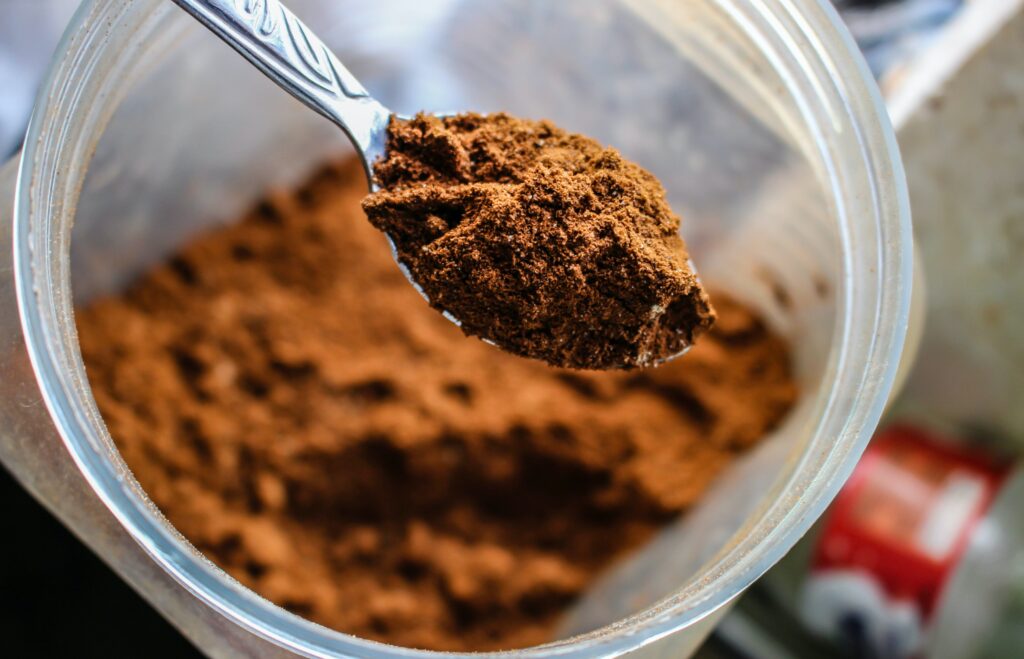Tag: sweets
A Halloween Treat to Enjoy: The Benefits of Dark Chocolate!
It’s no secret that I have a major sweet tooth. With Halloween right around the corner, you might think I’d have to hide myself away from all the sweets and candy… But the truth is, I have a great solution for my guilty pleasure. A sweet treat that leaves me feeling satisfied, and pretty happy with my healthy choices – dark chocolate!

I know that the debate between milk, white, and dark chocolate is hotly contested. But, when it comes down to the actual health benefits of dark chocolate, there is no question on the winner! That’s right, it has some serious health benefits that you don’t want to miss out on. I want to walk you through the pros of choosing dark chocolate, so you know exactly what candy to ‘borrow’ Sunday night from the kiddo’s Halloween baskets.
Fiber and Minerals
Dark chocolate is actually packed densely with nutrients. It seems crazy to think that a dessert is healthy for us, but it’s true! Now, it’s important to note that the real nutrition lies in the cacao seeds that chocolate comes from… Of course, to make it taste as delicious as it is, other ingredients (like sugar) are added. Which is why at minimum, we should aim for 70% dark chocolate or higher. The higher the percentage, the more bitter it may taste, but that’s because we are getting more of the real chocolate, and less of the sugar!
When it comes to the nutrient profile of high percentage dark chocolate, this sweet treat boasts an impressive resume. One bar of dark chocolate (about 100 grams) offers:
- 8 grams of protein
- 11 g of dietary fiber (44% DV)*
- 12 mg of iron (67% DV)
- 230 mg of magnesium (58% DV)
- 311 mg of phosphorus (31% DV)
- 722 mg of potassium (21% DV)
- 3.3 mg of zinc (22% DV)
- 1.8 mg of copper (89% DV)
- 2 mg of manganese (98%) [1]
*% DV means percentage of the Daily Value of a nutrient. This number is based on the needs of an average individual, and is based on a standard 2,000 calorie diet. Depending on the individual, you may need more or less than the % Daily Value, but it can be a helpful reference point!
Of course, you might not eat an entire bar of chocolate in one sitting, but this list is a good representation of how packed full of nutrients that dark chocolate is. It doesn’t stop there either. Keep reading, because it gets even better!
Rich in Antioxidants
Dark chocolate is also rich in antioxidants, particularly flavonols and polyphenols. These are just two of the many types of antioxidants, but they all essentially work the same.

Antioxidants fight against free radicals, and protect the body against oxidative damage. Free radicals are unstable molecules that can damage the healthy cells in our bodies in order to stabilize themselves. We accumulate free radicals from environmental exposure to toxins, such as tobacco smoke and UV light, and also as a natural byproduct of our body’s metabolic processes. Beta-carotene, and other antioxidants, protect against these free radicals by stabilizing and neutralizing them, rendering them benign. [2]
So, dark chocolate can also benefit your health by helping prevent oxidative damage in your body! This is also an important part of why it is also considered to be a heart healthy food. Let’s dig into the research on dark chocolate and heart health next!
Heart Health
Cardiovascular disease is the leading cause of death worldwide, killing nearly 18 million individuals every single year. [3] So, it’s pretty important to minimize our risk of heart disease as much as possible. The good news is that there are many modifiable risk factors that help reduce risk; lifestyle factors, such as diet, exercise, cessation of smoking, and moderating alcohol intake.
So, as you can probably guess, dark chocolate does fall into the ‘diet’ category when it comes to controlling risk factors associated with heart disease. There is actually a good amount of research to indicate that it can benefit our cardiovascular system, for a couple of reasons.
Dark Chocolate & Cholesterol
First, as an antioxidant, dark chocolate is able to limit the oxidation of LDL cholesterol (commonly known as the ‘bad’ cholesterol). Oxidized LDL cholesterol has interacted with free radicals, and can travel through the bloodstream causing damage to the circulatory and cardiovascular systems. As an antioxidant, it can contribute to suppressing the oxidation of LDL cholesterol, and offer protection to these systems.

Next, there has also been evidence to suggest that dark chocolate may contribute to a rise in HDL cholesterol (the ‘good’ cholesterol), and to the decrease in total cholesterol. High levels of cholesterol can contribute coronary artery disease, which means that there is buildup of cholesterol in the arteries that can cause blockages and damage to these vessels. While high LDL cholesterol and total cholesterol may increase your risk of coronary artery disease, HDL cholesterol helps keep the arteries clear, and transports cholesterol back to the liver for excretion. It seems dark chocolate has the ability to improve these clinical markers, which contributes to its heart healthy qualities. [4]
Dark Chocolate & Blood Pressure
Additionally, the flavanols in dark chocolate may be helpful in reducing blood pressure. There have been several studies to show that eating dark chocolate may help lower blood pressure, though the effect is pretty minimal. [5-6] Overall, its do seem to have an effect on overall risk of heart disease. This study found that those who ate a serving of dark chocolate five times per week were significantly less likely to develop heart disease compared to those who ate less dark chocolate, or didn’t eat any at all. [7]
A Healthy, Sweet Option
So, there you have it. If you’ve been looking for some way to make it through this Halloween without breaking your health streak, dark chocolate is the perfect compromise. A couple pieces here and there, and my sweet tooth is fully satisfied. And, I know I’m getting all those benefits that I listed above!

You can eat it plain and snack on a few squares from a chocolate bar, but I love to switch it up every once in a while, too! Here are some of my favorite, healthy treats that get an extra boost from a little dark chocolate.
- Apple + nut butter + dark chocolate chips
- Plain greek yogurt + drizzle of honey + granola + dark chocolate chips
- Strawberries + melted dark chocolate drizzle
- Mixed nuts + dried cranberries + dark chocolate chips
- S’mores – marshmallow + graham cracker + dark chocolate square
- Vanilla frozen yogurt + dark chocolate drizzle + Complete Collagen+ caramel drizzle
Well, to be honest, any of these desserts would be delicious with a drizzle of Complete Collagen+. Trust me, you have to try it! And you can, risk-free for 180 days with our money-back guarantee!
Citations
- Candies, Chocolate, Dark, 70-85% … – Self Nutrition Data. https://nutritiondata.self.com/facts/sweets/10638/2.
- “Understanding Antioxidants.” Harvard Health, 10 Jan. 2019, https://www.health.harvard.edu/staying-healthy/understanding-antioxidants.
- “Cardiovascular Diseases.” World Health Organization, World Health Organization, https://www.who.int/health-topics/cardiovascular-diseases#tab=tab_1.
- Baba, Seigo et al. “Plasma LDL and HDL cholesterol and oxidized LDL concentrations are altered in normo- and hypercholesterolemic humans after intake of different levels of cocoa powder.” The Journal of nutrition vol. 137,6 (2007): 1436-41. doi:10.1093/jn/137.6.1436
- Djoussé, Luc et al. “Chocolate consumption is inversely associated with prevalent coronary heart disease: the National Heart, Lung, and Blood Institute Family Heart Study.” Clinical nutrition (Edinburgh, Scotland) vol. 30,2 (2011): 182-7. doi:10.1016/j.clnu.2010.08.005
- Taubert, Dirk et al. “Effects of low habitual cocoa intake on blood pressure and bioactive nitric oxide: a randomized controlled trial.” JAMA vol. 298,1 (2007): 49-60. doi:10.1001/jama.298.1.49
- Hooper, Lee et al. “Effects of chocolate, cocoa, and flavan-3-ols on cardiovascular health: a systematic review and meta-analysis of randomized trials.” The American journal of clinical nutrition vol. 95,3 (2012): 740-51. doi:10.3945/ajcn.111.023457
